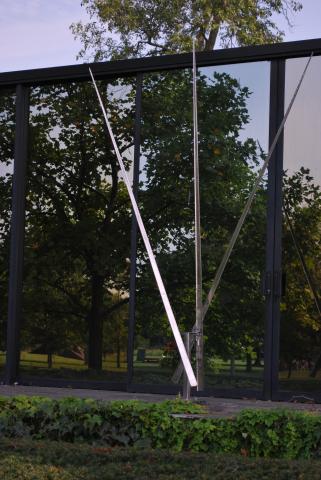Peristyle--Three Lines

*Indoors during the winter.
George Rickey was born in South Bend, Indiana in 1907. His father, an engineer for the Singer Sewing Machine Company, moved the family to Scotland in 1913. Rickey grew up abroad, graduating from Balliol College, Oxford, with a degree in modern history. His interest in art drew him to the Ruskin School of Drawing, also in Oxford, where he studied drawing and painting. He then moved to Paris for an additional year of study at the Académie Lhote and at the Académie Moderne under Fernand Léger and Amédée Ozenfant.
Rickey returned to the United States in 1934 in the midst of the Great Depression. He taught at various institutions across the country, often as part of the Carnegie Corporation’s Visiting Artists/Artists in Residence program. He served in the army from 1942 through 1945, where he designed machine gun turrets. After the war, the G.I. Bill enabled him to continue his art studies at the New York University Institute of Fine Arts and the Chicago Institute of Design. Rickey became a professor of architecture at Rensselaer Polytechnic Institute in Troy, New York, and worked in his studio in nearby East Chatham. In later years, he divided his time between East Chatham, Santa Barbara, California, and St. Paul, Minnesota. He died in St. Paul in 2002 at the age of 95.
While teaching at Indiana University in 1949, Rickey met sculptor David Smith, and by the early 1950s he had moved from painting to sculpture. The turn to sculpture was motivated by his fascination with movement. Unlike Alexander Calder, whose work he had first encountered in the 1930s, he was not interested in the aesthetics of movement or the forms produced by movement, but in the essence of movement. Applying his knowledge of engineering, he developed systems of weights that moved in response to air currents and gravity. In 1961, Rickey began making simplified abstract sculpture that investigated the movement of vertical steel blades. These blades had knife-edges as the points of support and balance. His system of movement allowed for a continually changing relationship between the lines that he referred to as kinetic drawing. These works established Rickey as an important sculptor, and he received commissions from all over the world. Ken Johnson, writing in The New York Times at the time of Rickey’s death, noted that “His work was often compared with Calder's, but while Calder's abstract mobiles had playful, organic qualities related to Surrealism, Mr. Rickey's geometric forms and machinelike engineering harked back to Constructivism.” Rickey published a book on Constructivism in 1967.
